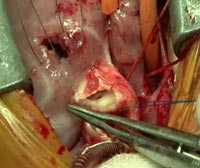ALERT!
This site is not optimized for Internet Explorer 8 (or older).
Please upgrade to a newer version of Internet Explorer or use an alternate browser such as Chrome or Firefox.
Surgical Repair of Common Arterial Trunk In a 2.6 kg Newborn Without a Conduit
EACTS Film Session 2008 Annual Meeting
Introduction
 We present a video of a surgical repair in a newborn with common arterial trunk type A1-2 in a 2.6 kg newborn. The view is from the patient’s head.
We present a video of a surgical repair in a newborn with common arterial trunk type A1-2 in a 2.6 kg newborn. The view is from the patient’s head.
Methods
A premature baby girl was admitted to the Children’s Heart Centre Slovakia with signs of congestive heart failure and failure to thrive. On echo a common arterial trunk type A1-A2 (Van Praagh) associated with a patent foramen ovale with near confluent pulmonary arteries was diagnosed. The patient was referred for complete repair. During the operation the ventricular septal defect was closed through a right ventriculotomy with a dacron patch by continuous suture. The common arterial trunk was incised longitudinally and after identifying the coronary ostia, the origin of the pulmonary arteries was excised with a button of surrounding tissue. The ascending aorta was sutured longitudinally. Both pulmonary arteries were mobilized. The button with the origin of the pulmonary arteries was directly anastomosed to the right ventriculotomy. The right ventricular outflow tract was reconstructed with a pericardial patch, connecting the right ventricle to the pulmonary arteries. The foramen ovale was left patent. The postoperative course was uneventful; the patient was extubated after 32 hours. The patient was discharged home on the 17th day with patent outflow tracts from both ventricles. There was a small leak on the septal defect patch and a gradient in the right ventricular outflow tract of 30 mm Hg.
Conclusion
Good functional result can be achieved by complete surgical repair of truncus arteriosus even in small neonates.



